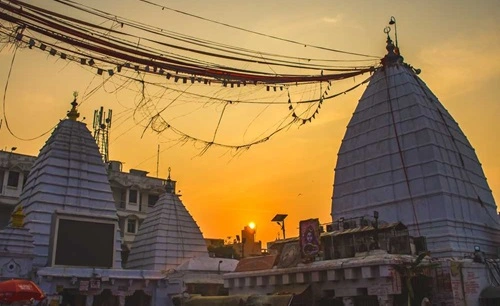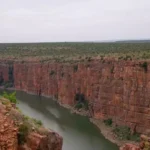Deoghar, also known as the “Abode of Gods,” is a sacred town in Jharkhand that attracts pilgrims, nature lovers, and history enthusiasts alike. Famous for the revered Baba Baidyanath Temple, one of the twelve Jyotirlingas of Lord Shiva, Deoghar is a place of immense spiritual significance for Hindus. In addition to its temples, the town offers serene landscapes, scenic hills, waterfalls, and charming ashrams, making it an appealing destination for travelers seeking peace and spirituality.
Choosing the best time to visit Deoghar ensures a comfortable and enriching experience, allowing visitors to explore its religious sites, natural beauty, and cultural festivities. Here’s a guide on the best seasons to visit Deoghar and what each has to offer.

Discovering the Sacred and Natural Beauty of Deoghar
Deoghar’s main attraction is the Baba Baidyanath Temple, where thousands of devotees gather to worship Lord Shiva, especially during the auspicious month of Shravan (July-August). The temple complex is an architectural marvel with intricate carvings and a serene ambiance. Apart from Baba Baidyanath Temple, Deoghar is home to several other important sites, such as Trikuta Hills, Satsang Ashram, Naulakha Mandir, and Tapovan, where visitors can find natural caves, meditation spots, and scenic viewpoints.
The town also hosts various cultural events and festivals, most notably the Shravan Mela, a major pilgrimage event that attracts millions of devotees from around India. For those interested in exploring Deoghar’s serene landscapes, the area offers lush greenery, hills, and rivers, creating a peaceful atmosphere that’s ideal for introspection and rejuvenation.
Best Seasons to Visit Deoghar
1. Winter (October to February)
Winter is considered the best season to visit Deoghar, as the weather is cool and pleasant, with temperatures ranging from 10°C to 22°C. The mild climate makes it ideal for exploring the temples, trekking up the Trikuta Hills, and visiting other outdoor attractions comfortably.
During winter, devotees can explore the Baba Baidyanath Temple complex without the rush that accompanies the summer pilgrimage season. The cool mornings and evenings add to the peaceful ambiance, making it an ideal time for meditation and prayer. The scenic Trikuta Hills are especially enjoyable to visit in winter, as the trails offer beautiful panoramic views of the town and surrounding countryside. The moderate temperature allows travelers to trek up to the hilltop temples, relax, and take in the beauty of the region without feeling fatigued.
Winter is also the perfect time for visiting Naulakha Mandir, known for its intricate architecture and resemblance to the famous Ramakrishna Temple in Belur, West Bengal. The serene environment and cool weather make it an ideal season for both sightseeing and quiet reflection.
If you’re a cultural enthusiast, consider visiting Deoghar in early winter to witness the Durga Puja celebrations, held in October. This festival brings vibrant decorations, traditional rituals, and a festive spirit to Deoghar, showcasing the region’s cultural richness.
2. Summer (March to June)
Summer in Deoghar can be quite warm, with temperatures ranging from 25°C to 40°C. While the heat can make daytime exploration challenging, early mornings and evenings remain comfortable, allowing for visits to temples and other sites.
Despite the high temperatures, summer is an important season for pilgrims, as it leads into the Shravan month, when devotees begin preparing for the annual pilgrimage. Summer is a quieter time to explore the Baba Baidyanath Temple without the overwhelming crowds that accompany the Shravan Mela in July and August. Many devotees visit in the early summer months to seek blessings and perform rituals in a more peaceful setting.
If you’re interested in exploring Deoghar’s natural beauty, visit early in the summer to enjoy spots like Tapovan Caves, where you can find cool interiors and shaded areas ideal for meditation. The surrounding hills and caves offer refuge from the heat, providing peaceful spots for relaxation and spiritual reflection.
For those who don’t mind the heat, summer offers the advantage of fewer tourists and a quieter experience, allowing you to take in Deoghar’s attractions at a relaxed pace. However, it’s essential to carry water, wear light clothing, and stay hydrated if you’re visiting during this season.
3. Monsoon (July to September)
Monsoon in Deoghar brings moderate to heavy rainfall, with temperatures ranging from 20°C to 30°C. The rains transform the town’s landscape, making the surrounding hills, gardens, and forests lush and green. Monsoon is a beautiful time for nature lovers, as the rainy season brings a fresh, revitalized look to Deoghar’s landscapes.
The monsoon season also marks the start of the Shravan Mela, held in July and August, making it the most significant pilgrimage period for Deoghar. Millions of devotees from across India visit the Baba Baidyanath Temple to perform rituals and seek blessings. The temple town comes alive with colorful decorations, devotional songs, and traditional performances, creating a unique spiritual atmosphere.
While the rains add to the beauty of Deoghar, monsoon may not be the best time for outdoor activities like trekking due to the slippery trails. However, if you’re a pilgrim or are keen to witness the grandeur of Shravan Mela, monsoon is the perfect season to experience Deoghar’s religious fervor and cultural traditions. Be prepared for crowds and occasional rain showers, and carry rain gear to navigate comfortably.
Key Attractions and Activities in Deoghar
- Baba Baidyanath Temple: The temple is the most famous attraction in Deoghar and one of the twelve Jyotirlingas dedicated to Lord Shiva. Known for its architectural beauty and spiritual significance, the temple complex is a peaceful place for prayer and reflection.
- Trikuta Hills: This scenic hill range offers trekking opportunities and houses several smaller temples. The viewpoint at the top provides a stunning panoramic view of the Deoghar landscape and is especially beautiful in winter.
- Naulakha Mandir: Resembling the Ramakrishna Temple in Belur, this mandir is famous for its elegant architecture. The peaceful surroundings and intricate design make it an ideal spot for meditation and photography.
- Satsang Ashram: Founded by the followers of Thakur Anukul Chandra, this ashram is a place of spirituality and learning. It attracts devotees and tourists interested in meditation, spiritual discourses, and traditional ashram life.
- Tapovan Caves and Hills: Located a few kilometers from Deoghar, Tapovan has several natural caves, temples, and meditation spots. It’s a serene place for those interested in exploring Deoghar’s natural beauty and spiritual heritage.
- Rikhia Peeth: An important spiritual center founded by Swami Satyananda Saraswati, Rikhia Peeth is known for its teachings on yoga and spirituality. The ashram conducts various workshops, attracting seekers from across the world.
Practical Tips for Visiting Deoghar
- Temple Timings: The Baba Baidyanath Temple is open from early morning to late evening, with specific hours for rituals and darshan. Early morning visits are ideal for avoiding crowds.
- Weather-Appropriate Clothing: Dress comfortably according to the season. Light, breathable clothes are suitable for summer, while rain gear is essential for monsoon. Carry warm layers for winter mornings and evenings.
- Accommodation: Deoghar offers a range of accommodation options, from budget guesthouses to mid-range hotels and dharamshalas. Booking in advance is recommended during the Shravan Mela.
- Respect Local Customs: Deoghar is a religious town, so it’s advisable to dress modestly, especially when visiting temples and ashrams. Follow temple protocols, such as removing footwear and maintaining silence.
- Stay Hydrated: If you’re visiting during summer, keep yourself hydrated and carry water bottles. It’s also advisable to carry snacks, as some areas may have limited food options.
Conclusion
Deoghar offers a unique mix of spirituality, culture, and natural beauty, making it an ideal destination for those seeking peace and a connection to India’s religious heritage. From the bustling winter season to the vibrant monsoon pilgrimage of Shravan Mela and the quiet summer mornings, each season provides a unique experience of Deoghar’s charm. Whether you’re here for pilgrimage, to explore scenic landscapes, or to enjoy local traditions, planning your visit around the best time ensures a fulfilling and memorable journey in Jharkhand’s sacred town.


